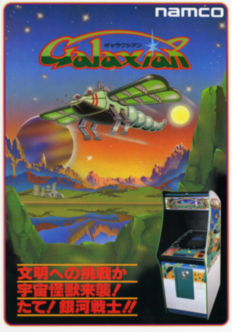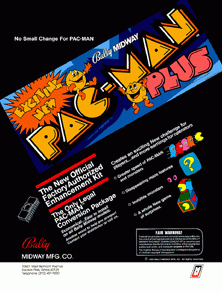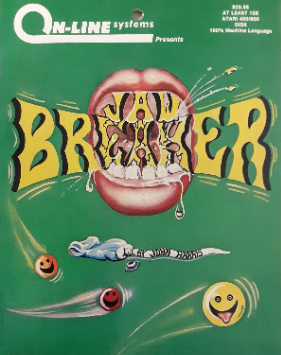Pac-Man is a popular 1980 arcade game by Namco.
Contents
Pac-Man may also refer to:
Pac-Man is a popular 1980 arcade game by Namco.
Pac-Man may also refer to:

The Atari 2600 is a home video game console developed and produced by Atari, Inc. Released in September 1977 as the Atari Video Computer System, it popularized microprocessor-based hardware and games stored on swappable ROM cartridges, a format first used with the Fairchild Channel F in 1976. The VCS was bundled with two joystick controllers, a conjoined pair of paddle controllers, and a game cartridge—initially Combat and later Pac-Man. Sears sold the system as the Tele-Games Video Arcade. Atari rebranded the VCS as the Atari 2600 in November 1982 alongside the release of the Atari 5200.

Pac-Man, originally called Puck Man in Japan, is a 1980 maze action video game developed and released by Namco for arcades. In North America, the game was released by Midway Manufacturing as part of its licensing agreement with Namco America. The player controls Pac-Man, who must eat all the dots inside an enclosed maze while avoiding four colored ghosts. Eating large flashing dots called "Power Pellets" causes the ghosts to temporarily turn blue, allowing Pac-Man to eat them for bonus points.

Frogger is a 1981 arcade action game developed by Konami and manufactured by Sega. In North America, it was released by Sega/Gremlin. The object of the game is to direct five frogs to their homes by dodging traffic on a busy road, then crossing a river by jumping on floating logs and alligators.

Ms. Pac-Man is a 1982 maze arcade video game developed by General Computer Corporation and published by Midway. It is the first sequel to Pac-Man (1980) and the first entry in the series to not be made by Namco. Controlling the title character, Pac-Man's wife, the player is tasked with eating all of the pellets in an enclosed maze while avoiding four colored ghosts. Eating the larger "power pellets" lets the player eat the ghosts, who turn blue and flee.

Miner 2049er is a platform game developed for the Atari 8-bit family of home computers by Bill Hogue and released by his company, Big Five Software, in 1982. The player controls Bounty Bob through multiple levels of a mine, with the goal of traversing all of the platforms while avoiding or defeating enemy mutants. At a time when "climbing games" such as Donkey Kong had four screens, Miner 2049er had ten.

Galaxian is a 1979 fixed shooter arcade video game developed and published by Namco. The player assumes control of the Galaxip starfighter in its mission to protect Earth from waves of aliens. Gameplay involves destroying each formation of aliens, who dive down towards the player in an attempt to hit them.

Pac-Man Plus is an arcade game that was released by Bally Midway in 1983. It is part of the Pac-Man series of games.

Jr. Pac-Man is an arcade video game developed by General Computer Corporation and released by Bally Midway on August 13, 1983. It has the same gameplay as prior entries in the series, but the maze in Jr. Pac-Man scrolls horizontally and has no escape tunnels. The bonus item which moves around the maze changes dots into a form which slows Jr. Pac-Man as they are being eaten.
1982 was the peak year for the golden age of arcade video games as well as the second generation of video game consoles. Many games were released that would spawn franchises, or at least sequels, including Dig Dug, Pole Position, Mr. Do!, Zaxxon, Q*bert, Time Pilot and Pitfall! The year's highest-grossing video game was Namco's arcade game Pac-Man, for the third year in a row, while the year's best-selling home system was the Atari 2600. Additional video game consoles added to a crowded market, notably the ColecoVision and Atari 5200. Troubles at Atari late in the year triggered the video game crash of 1983.
1980 saw the release of a number of games with influential concepts, including Pac-Man, Battlezone, Crazy Climber, Mystery House, Missile Command, Phoenix, Rally-X, Space Panic, Stratovox, Zork, Adventure, and Olympic Decathlon. The year's highest-grossing video game was Namco's arcade game Pac-Man, while the best-selling home system was Nintendo's Game & Watch. The Atari VCS also grew in popularity with a port of Space Invaders and support from new third-party developer Activision.

The Atari Flashback series are a line of dedicated video game consoles designed, produced, published and marketed by AtGames under license from Atari SA. The Flashback consoles are "plug-and-play" versions of the Atari 2600 console. They contain built-in games rather than using the ROM cartridges utilized by the 2600. Most of the games are classics that were previously released for the 2600, although some Flashback consoles include previously unreleased prototype games as well.
Tod R. Frye is an American computer programmer once employed by Atari, Inc., and is most notable for developing the home adaptation of Pac-Man for the Atari 2600 video computer system. Following the collapse of Atari he worked at video game and computer game companies such as 3DO and Pronto Games.

Pac-Man is a 1982 maze video game developed and published by Atari, Inc. under official license by Namco, and an adaptation of the 1980 hit arcade game of the same name. The player controls the title character, who attempts to consume all of the wafers in a maze while avoiding four ghosts that pursue him. Eating flashing wafers at the corners of the screen causes the ghosts to temporarily turn blue and flee, allowing Pac-Man to eat them for bonus points. Once eaten, a ghost is reduced to a pair of eyes, which return to the center of the maze to be restored.

Jawbreaker is a Pac-Man clone programmed by John Harris for the Atari 8-bit family and published by On-Line Systems. Released in 1981 before an official version of Pac-Man was available, it was widely lauded by reviewers and became a major seller. The story of its creation and Harris's Atari 8-bit implementation of Frogger form a portion of Steven Levy's 1984 book, Hackers: Heroes of the Computer Revolution.

Atari, Inc. was an American video game developer and home computer company founded in 1972 by Nolan Bushnell and Ted Dabney. Atari was a key player in the formation of the video arcade and video game industry.

Squeeze Box: The Complete Works of "Weird Al" Yankovic is a 15-album box set by American comedy musician "Weird Al" Yankovic, released on November 24, 2017. Squeeze Box marks Yankovic's second box set since 1994's Permanent Record: Al in the Box.